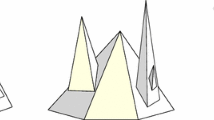Abstract
This paper introduces two efficient algorithms that compute the Contour Tree of a three-dimensional scalar field F and its augmented version with the Betti numbers of each isosurface. The Contour Tree is a fundamental data structure in scientific visualization that is used to pre-process the domain mesh to allow optimal computation of isosurfaces with minimal overhead storage. The Contour Tree can also be used to build user interfaces reporting the complete topological characterization of a scalar field, as shown in Figure~\ref{fig:top}. Data exploration time is reduced since the user understands the evolution of level set components with changing isovalue. The Augmented Contour Tree provides even more accurate information segmenting the range space of the scalar field into regions of invariant topology. The exploration time for a single isosurface is also improved since its genus is known in advance. Our first new algorithm augments any given Contour Tree with the Betti numbers of all possible corresponding isocontours in linear time with the size of the tree. Moreover, we show how to extend the scheme introduced in [3] with the Betti number computation without increasing its complexity. Thus, we improve on the time complexity in our previous approach from O(m log m) to O(n log n + m), where m is the number of cells and n is the number of vertices in the domain of F. Our second contribution is a new divide-and-conquer algorithm that computes the Augmented Contour Tree with improved efficiency. The approach computes the output Contour Tree by merging two intermediate Contour Trees and is independent of the interpolant. In this way we confine any knowledge regarding a specific interpolant to an independent function that computes the tree for a single cell. We have implemented this function for the trilinear interpolant and plan to replace it with higher-order interpolants when needed. The time complexity is O(n + t log n), where t is the number of critical points of F. For the first time we can compute the Contour Tree in linear time in many practical cases where t = O(n 1–ε). We report the running times for a parallel implementation, showing good scalability with the number of processors.
Similar content being viewed by others
Author information
Authors and Affiliations
Corresponding authors
Rights and permissions
About this article
Cite this article
Pascucci, V., Cole-McLaughlin, K. Parallel Computation of the Topology of Level Sets. Algorithmica 38, 249–268 (2004). https://doi.org/10.1007/s00453-003-1052-3
Received:
Revised:
Published:
Issue Date:
DOI: https://doi.org/10.1007/s00453-003-1052-3




